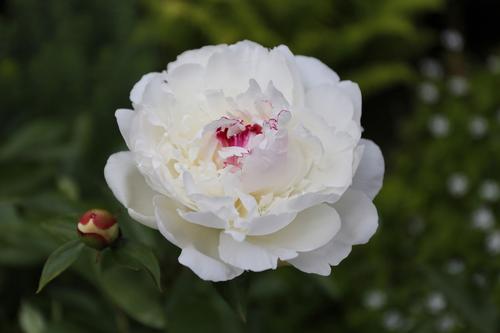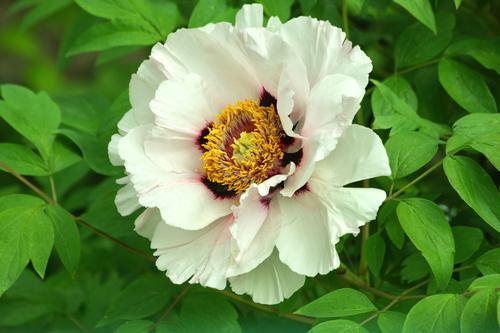Tips for Growing Peonies in Zones 7-9
There are many kinds of flowering plants that need to go through a cold winter in order to bloom properly. The list includes everything from spring-flowering bulbs to lilacs, apple trees...and peonies.
It can be challenging to grow peonies in the south, where winter temperatures rarely fall below freezing for more than a couple days at a time. But success is possible! The key is to start with the right type of peony and plant it correctly.
Herbaceous Peonies
Most classic garden peonies are herbaceous. This means the plants die to the ground in late fall and emerge again in spring. New growth sprouts from modified stems that lie just below the soil surface.
There are about 30 species of herbaceous peonies. The one that's most common in the horticultural world is Paeonia lactiflora. These plants, which are native to China, tend to be about 40" tall and produce multiple buds on each stem. They are extremely cold-hardy and able to tolerate temperatures as low as -40°F.
These herbaceous peonies also require a long winter dormancy – at least six weeks at temperatures that stay consistently below 40-45°F. For this reason, they are not the best peonies for the south. Cultivars of P. lactiflora such as Bowl of Beauty, Sarah Bernhardt and Festiva Maxima grow best in cold climates (hardiness zones 3-7).

Most other species peonies are not commonly available. But plant breeders have combined them with P. lactiflora to create many valuable hybrids. Hybrid herbaceous peonies are available in a wide range of heights, colors and bloom times and typically have stronger stems and fewer side buds than P. lactiflora.
All hybrid herbaceous peonies are suitable for zones 3-7 and some can be grown successfully in zone 8. Heat tolerance varies by cultivar, depending on which species were combined to create the hybrid.
Some of the herbaceous peony cultivars that have proven to grow well in warm climates include: America, Blaze, Coral Charm, Felix Crousse, Festiva Maxima, Halcyon, Kansas, Krinkled White, Miss America, Mrs. Franklin D. Roosevelt, Paul M. Wild, Paula Fay, Red Charm, Scarlet O’Hara and Shirley Temple.

Tree Peonies
Tree peonies (Paeonia suffruticosa) are long-lived, woody shrubs that can grow 6 feet tall and 4 feet wide. They bloom earlier than all other types of peonies and their enormous flowers can measure up to 10 inches across.
Tree peonies require a winter dormancy period, but temperatures do not need to drop below freezing. For this reason, most tree peony cultivars grow well in zones 4-9. If you add a tree peony to your garden or landscape, choose the planting location carefully. While all other types of peonies flower best in full sun, tree peonies actually prefer growing in dappled shade.
When planting tree peonies, position the crown of the plant (where roots meet stem) 4 to 6” below the soil surface. Tree peonies that have proven to be especially heat tolerant include Snow Lotus, Pink Lotus and Cup of Shining Night.

Intersectional Peonies
Intersectional peonies (also known as Itohs) are shorter than tree peonies and herbaceous peonies. They bloom just after the other two. The flowers are typically about 8" across and are available in many different colors. Intersectional peonies are more tolerant of heat and humidity than herbaceous hybrids, and most will grow well in zones 4-9. Examples include Bartzella, Keiko and White Emperor.

Tips for Growing Peonies in the South
When choosing a planting location, look for microclimates where the soil stays cooler than normal. Full morning sun and dappled afternoon shade is ideal. Planting your peony near a large shrub is another way to give it some protection from afternoon heat. Plan to provide drip irrigation from late spring through early fall. After planting, cover the soil with a 1-2" layer of mulch to help retain moisture.
When growing peonies in the south, favor early-blooming varieties so your plants bloom before the weather gets too hot. Gardeners in zones 8-9 find peonies with single or semi-double flowers tend to perform better than doubles.
In warm climates, herbaceous peonies should be planted even more shallowly than in the north. Position the thick, tuberous roots, which are actually modified stems, just 1/2 to 1” below the soil surface.
In zone 9, herbaceous hybrids and intersectional peonies may need to be forced into dormancy. To do this, cut the plants back to the ground in November. This mimics the natural leaf drop that would occur in colder climates.

The general rule for growing peonies in the south is this: if people in your neighborhood can grow apples, you can probably grow peonies. Keep in mind that most newly planted peonies take at least 3 years to produce a good show of flowers. For general planting and care instructions, you may also be interested in reading the following articles:

